Installationsanleitung
IQ8MCP - Elektronikmodul
Installation Instruction
IQ8MCP - Electronic module
(Art.-Nr. / Part No. 804905 / 804906
798934
D
GB
Technische Änderungen vorbehalten!
Technical changes reserved!
09.2018 / AA
© 2018 Honeywell International Inc.
Novar GmbH a Honeywell Company
Dieselstraße 2, D-41469 Neuss
Internet: www.esser-systems.com
E-Mail: info@esser-systems.com
D
Bei dem Einsatz des MCP als Handfeuermelder muss zwingend ein
rotes Gehäuse und die normenkonforme Symbolik gemäß Abb. 4 und
5 verwendet werden.
Andere Gehäusefarben und Beschriftungen gelten nicht als
Handfeuermelder sondern als manuelle Auslösevorrichtung.
Klemmen 1-4 UL
IN
(Eingang) UL
OUT
(Ausgang).
Fernmeldekabel I-Y (St) Y n x 2 x 0,8 mm oder vergleichbar mit
besonderer Kennzeichnung oder Brandmeldekabel verwenden!
Durch den Anschluss der Kabelabschirmung werden die
Signalleitungen gegen Störeinflüsse geschützt.
Bei Servicearbeiten an dem MCP eine evtl. vorhandene
Alarmweiterleitung, wie zum Beispiel die unbeabsichtigte
Auslösung einer Alarmübertragungseinrichtung (AÜE), beachten.
Verwendung des Serviceschlüssels (Art.-Nr. 769916) ausschließlich
durch autorisierte Personen!
Ergänzende und aktuelle Informationen
Die Produktangaben entsprechen dem Stand der Drucklegung und
können durch Produktänderungen, geänderte Normen / Richtlinien
ggf. von den hier genannten Informationen abweichen.
Aktualisierte Informationen, Konformitätserklärungen und
Instandhaltungsvorgaben siehe www.esser-systems.com.
Dokumentation der Brandmelderzentrale bzgl. Normen, lokalen
Anforderungen und Systemvoraussetzungen beachten!
§
Handmelder und automatische Brandmelder dürfen gemäß den VdS-
Richtlinien nicht auf einer gemeinsamen Meldergruppe betrieben
werden (max. 10 Handmelder / Gruppe).
GB
When the device is used as a MCP it must be installed in a red housing
with an identification label showing the correct symbol as shown in
Fig. 4 and 5.
When housings with different colours and identification labels are
used the unit is classed as a manual activation device and not as a
MCP.
Observe the correct wiring sequence for the loop!
Terminals 1-4 UL
IN
(Input) UL
OUT
(Output).
Use clearly identified cable I-Y (St) Y n x 2 x 0,8 mm and employ
only shielded twisted pair cables with special designation for fire
detection and consider furthermore the requirements of the local
standard!
The shielding must be connected for EMI protection of the cable!
The alarm activation and triggering of notifying systems e.g. fire
alarm routing equipment (FARE) must be observed during any
Service of the MCP.
The service key (Part No. 769916) must only be used by authorized
persons!
Additional and updated Informations
The product specification relate to the date of issue and may differ
due to modifications and/or amended Standards and Regulations
from the given informations.
For updated informations, declaration of conformity and maintenance
specifications refer to www.esser-systems.com.
Observe technical manuals of the FACP to ensure compliance to
standards and local requirements of Systems features!
§
Pursuant to the VdS guidelines MCPs and automatic fire detectors
must not be operated in a common detector zone
(max. 10 MCP per detector zone).
D
Achtung!
Diese Anleitung muss vor der Inbetriebnahme des Gerätes genau durch-
gelesen und verstanden werden. Bei Schäden, die durch Nichtbeachtung der
Installationsanleitung verursacht werden, erlischt der Gewährleistungs-
anspruch. Für Folgeschäden, die daraus resultieren, wird keine Haftung
übernommen.
Sicherheitshinweise
Der MCP darf NICHT an eine 230 V AC Netzspannung angeschlossen und
nur im vorgesehenen Temperaturbereich betrieben werden.
Die Wartung und Reparatur des MCP darf nur durch eine Fachkraft erfolgen, die
mit den damit verbundenen Gefahren und Vorschriften vertraut ist.
Die Veränderung oder ein Umbau des Melders ist nicht zulässig.
Allgemein / Anwendung
Das Elektronikmodul im roten Gehäuse mit dem Symbol „brennendes Haus“
wird als Handfeuermelder zur manuellen Auslösung eines Brandalarmes
bzw. einer Gefahrenmeldung in trockenen, nicht explosionsgefährdeten
Betriebs-stätten eingesetzt. Der MCP ist für andere Verwendungen auch in
verschiedenen Ausführungen, wie z.B. unterschiedlichen Gehäusefarben und
verschieden bedruckten Einlegern verfügbar (siehe Tabelle Seite 2).
Die Betriebsbereitschaft des MCP wird durch die blinkende grüne LED 1 (A)
angezeigt (Abb. 1).
Bedienung
Auslösen:
Glasscheibe eindrücken und Druckknopf bis zum Einrasten
drücken
- rote LED (B) blinkt.
Zum Einstecken des Schlüssels die Schlüssellochabdeckung (C)
hochschieben (Abb. 3).
Serviceschlüssel (F) nur bei Elektronikmodulen ab Index 05 und
gelber Schließung einsetzbar (Abb. 2).
Testbetrieb: Vor der Testauslösung die Alarmweiterleitung beachten
und ggf. abschalten!
Serviceschlüssel (F) einstecken und bis zum Endanschlag
in Richtung ( Test) drehen.
Rückstellen: Schlüssel (E) oder (F) einstecken, in Richtung
( Test) drehen bis der Druckkopf wieder gelöst wird.
Öffnen: Schlüssel (E) einstecken und bis zum Lösen der
Verriegelung (D) in Richtung ( OPEN) drehen. Das
Gehäuseoberteil leicht nach oben ankippen und von dem
Gehäuseunterteil abnehmen (Abb. 3).
Schließen:
Schließung mit dem Schlüssel in Mittelstellung (Abb. 3)
bringen, Vorderteil leicht angekippt auf die oberen
Vertiefungen des Unterteiles aufsetzen und vorsichtig bis
zum Einrasten zudrücken.
Beschriftung: In Betrieb
Folie (Abb. 4) in die obere Halterung (G) einlegen und unter
die Führung (H) schieben.
Außer Betrieb
Zur Kennzeichnung eines nicht betriebsbereiten MCP die
Folie umdrehen (Abb. 4).
Transparente Abdeckung (Abb. 5) bei geöffnetem
Meldergehäuse an den Punkten (J) lösen und entnehmen.
Gewünschtes Beschriftungsfeld (K) von Vorne einlegen.
Abdeckung an der Markierung/Ziffer (L) ausrichten und
lagerichtig wieder aufdrücken.
Glasscheibe:
Vor dem Wechsel evtl. vorhandene Glassplitter vorsichtig
entfernen! Glasscheibe angewinkelt in Position (M)
einsetzen und soweit mit leichtem Druck gegen die
Kunststoffzunge drücken bis die Glasscheibe unter die
beiden Haltewinkel (N) passt (Abb. 6).
Klemmen: Die Anschlussklemmen 1-4 und 5-8 können zur
Vereinfachung der Installation abgezogen werden.
An die Klemme in der linken oberen Ecke des
Gehäuseunterteiles muss die Abschirmung des
Anschlusskabels angeschlossen werden (Abb. 7/8).
Installation
Der MCP muss auf einer glatten, geeigneten Wandfläche, z.B. mit Dübeln (S6)
und 2-4 Schrauben (Länge ≥ 40 mm) befestigt werden.
IP 55 Schutz (Option)
Zur Erhöhung der Schutzart von IP 44 auf IP 55 den Schutzschlauch (O)
(Art.-Nr. 704917) für die Anschlussklemmen verwenden. Anschlusskabel im
MCP zum Schutz vor Feuchtigkeit mit Abtropfschlaufe verlegen (Abb. 7).
Anschaltung (Abb. 8)
Die Anschaltung des MCP erfolgt über den esserbus
®
/ esserbus
®
-PLus der ESSER-
Brandmelderzentralen. Kabel nur innerhalb des Gehäuses abisolieren.
Elektronikmodul mit Leitungstrenner und ext. Meldergruppe (Art.-Nr. 804905)
Die Leitungstrenner gewährleisten die Funktionstüchtigkeit der Anlage, falls ein
Segment der Ringleitung durch Kurzschluss ausfällt. Dann öffnen die Leitungs-
trenner vor und hinter dem Kurzschluss und schalten den Teil der Ringleitung
zwischen den Leitungstrennern ab. Ein einfacher Drahtbruch beeinträchtigt die
Funktion der Ringleitung nicht. An diesen MCP kann eine externe Meldergruppe
mit max. zehn Standard MCP (interner Alarmwiderstand jeweils 1 KOhm) ange-
schlossen werden. Bei einer Auslösung wird die Adresse und der programmierte
Zusatztext des MCP angezeigt, an dem die ext. Meldergruppe angeschlossen ist.
Leitungslänge max. 500 Meter! Den letzten MCP mit einem 10 KOhm
Abschlusswiderstand beschalten (Abb. 8). Wird keine ext. Meldergruppe ange-
schlossen, den 10 KOhm Widerstand direkt an den Klemmen 7/8 anschalten.
MCP mit Relaisausgang (Art.-Nr. 804906)
An der Anschlussklemme 6/7/8 stehen potentialfreie Kontakte eines
Wechslers NC/C (Öffner) oder NO/C (Schließer) zur Verfügung (Abb. 8). Der
Relaisausgang wird mit dem Auslösen dieses MCP aktiviert. Der Relais-
ausgang kann in den Kundendaten der BMZ als Steuergruppe programmiert
werden. Die max. Kontaktbelastung max. 30 V DC / 1A.
Technische Daten
Betriebsspannung : 8 V DC bis 42 V DC
Ruhestrom : ca. 45 µA @ 19 V DC
Alarmstrom : ca. 9 mA @ 19 V DC
Melderzahl : max. 127 MCPs pro Ringleitung
Betriebsanzeige : blinkende LED 1, grün
Alarmanzeige : blinkende LED 2, rot
Anschlussklemmen : max. 1,5 mm² (AWG 30-14)
Anwendungstemperatur : -40 °C bis +70 °C
Lagertemperatur : -40 °C bis +75 °C
Schutzart : IP 44 (im Gehäuse)
IP 55 (mit Option)
Gehäuse : PC ASA-Kunststoff
Gewicht : ca. 236 g (im Gehäuse)
Maße-Gehäuse (B x H x T) : 133 x 133 x 36 (mm)
Spezifikation : EN 54-11 : 2001 /-17 : 2005, Typ B
(nur Handfeuermelder)
VdS-Anerkennung : G 205002
Leistungserklärung : DoP-20488130701,
DoP-20489130701
GB
Important!
These instructions must be studied carefully and understood before
commissioning the device. Any damage caused by failure to observe the
installation instructions voids the warranty. Furthermore, no liability can be
accepted for any consequential damage arising from such failure.
Safety information
NEVER connect the call point directly to a 230 V AC mains power supply
and operate the call point in the specified ambient temperature range.
Only qualified technicians who are fully familiar with all the associated
hazards and the applicable legislation and regulations may perform
maintenance and repair work on the call point.
The call point may not be changed or modified in any way.
General / Application
The electronic module in the red housing identified with a “burning house”
symbol is designated for use as a call point for manually triggering fire alarms
or other hazard alarms in dry workplaces not subject to explosion hazards.
The call point is also available in other versions for other applications, for
example in housings with different colours and with a choice of different
identification labels (refer to table - page 2). The operation mode is displayed
via the flashing green LED 1 (A), (Fig. 1).
Operation
Trigger alarm:
Break glass and press button in firmly so that it clicks into
position and red LED 2 (B) is flashing.
Push up the keyhole cover (C) to insert the key (Fig. 2).
Service key (F) only for use with electronic module from index 05
and yellow colored key lock (Fig. 2).
Test mode: Please observe connected notifying systems before test
activation.
Insert the service key (F) and turn all the way in the
( Test) direction.
Reset: Insert the key (E) or (F) and turn it in direction
( Test) until the pressed button is released.
Opening the unit: Insert the key (E) and turn in the ( OPEN) direction to
release the cover lock (D). Lift up the bottom edge of the
cover a little to release it and then remove the cover
(Fig. 3).
Closing the unit: With the key in the centre position to release the lock
(Fig. 3) position the upper edge of the cover in the groove
at the top of the base and then press the cover down until
it locks into position.
Identification: In Operation
Position the plastic label (Fig. 4) on the retaining pins (G)
and push it under the guides (H).
Out-of-Order
The other side of the label can be used for identifying call
points that are not in operation (Fig. 4).
With the call point housing open remove the transparent
plastic label cover (Fig. 5) by prising it out at points (J). Then
insert the appropriate identification label (K) from the front.
Align the cover with the mark/number (L) and snap it back
into place, checking that it is aligned correctly.
Glass screen:
Remove carefully any possibly existing broken splinters
before replacing the glass! Push the top edge of the
replacement screen up against lug (M) and then press the
screen gently into position so that it snaps under the two
retaining lugs (N) at the bottom of the window (Fig. 6).
Terminals: The terminals 1-4 and 5-8 can be removed if desired to
make the installation procedure easier.
Connect the shield of the connection cable to the ground
terminal in the upper left corner of the housing base
(Fig. 7/8).
Installation
The MCP must be fixed to a suitable, smooth wall surface, e.g. with wall plugs
(S6) and 2-4 screws (length ≥ 40 mm).
Protection rating IP 55 (option)
To achieve a higher IP-rating from IP 44 to IP 55 cover the terminals with
the appropriate shrink sleeve (O) (Part No. 704917). Install inlaying cable
with a dripping bend to protect the device from dampness (Fig. 7).
Wiring (Fig. 8)
The MCP are connected via esserbus
®
/ esserbus
®
PLus of the ESSER fire
alarm control panels. Only strip the cables within the housing.
Zone isolator and ext. D-Line (Part No. 804905)
The zone isolators ensure that the system continues to function even if a
segment of the loop circuit fails due to a short circuit. The zone isolators before
and after the short open, disconnecting the section of the loop between the
isolators. Simple wire breaks do not affect the functionality of the loop circuit.
You can connect an external detector zone (D-line) with up to ten MCP (internal
Alarm resistor for each detector 1 KOhm) to this MCP and configure required
operation with tools 8000. When an alarm is triggered the address and the
programmed additional text of the MCP to which the conventional zone is
connected are displayed automatically. Cable length max. 500 metres! Fit the
last call point with a 10 KOhm EOL terminating resistor (Fig. 8). If no ext.
detector zone is connected the 10 KOhm terminating resistor must be
connected directly across terminals 7/8.
Call point with relay output (Part No. 804906)
The floating contacts of a changeover relay NC/C (break) or NO/C (make) are
available on terminals 6/7/8 (Fig. 8). The relay output is activated automatically
when this MCP is triggered. The relay output can be programmed as a control
zone in the customer data of the FACP. The contact rating max. 30 V DC / 1A.
Specifications
Power supply : 8 V DC to 42 V DC
Quiescent current : approx. 45 µA @ 19 V DC
Alarm current : approx. 9 mA @ 19 V DC
No. of call points : max. 127 MCPs per loop
Operation indicator : flashing LED 1, green
Alarm indicator : flashing LED 2, red
Connection terminals : max. 1.5 mm² (AWG 30-14)
Application temperature : -40 °C to +70 °C
Storage temperature : -40 °C to +75 °C
Protection rating : IP 44 (in housing)
IP 55 (with option)
Housing : PC ASA plastic
Weight : approx. 236 g (with housing)
Housing dimensions (w x h x d) : 133 x 133 x 36 (mm)
Specification : EN 54-11 : 2001 /-17 : 2005, type B
(only MCPs in red housing)
VdS approval : G 205002
Declaration of Performance : DoP-20488130701,
DoP-20489130701
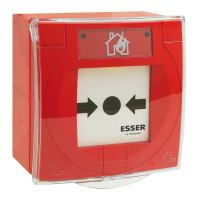
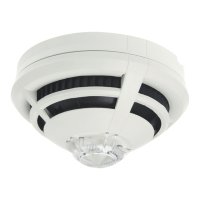
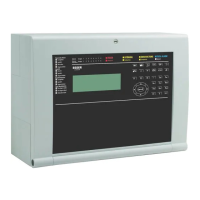
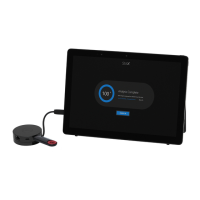
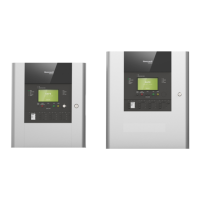
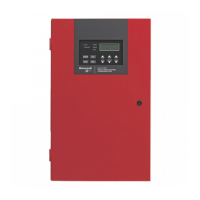
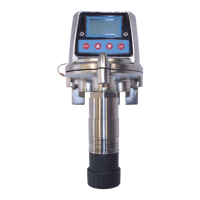
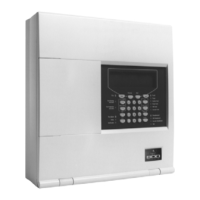
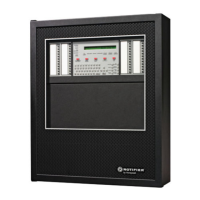
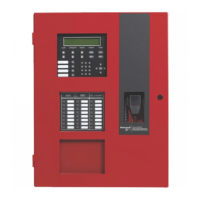
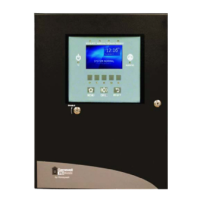
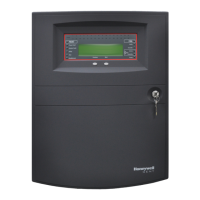

